Choosing a camping stove can be difficult as there are many good ones available. None of those reviewed could be described as poor. How then do you decide which stove is best for you? That depends on several factors. How many people will it be used for? A stove for several people needs to support big pots. A stove for solo use can be minimalist and ultralight. When will the stove be used? All stoves work fine in warm weather. Not all work well in the cold. Which fuel is best? For short trips where it will all be carried from home this doesn’t matter. For longer trips you need to know what fuel will be available along the way. Fuel efficiency matters as well – the better it is the less often you’ll need to resupply. Do you just want a stove to boil water or one that simmers so you can do some real cooking? Not all stoves have easily controlled flames.
With any stove you need a pot or two. Some models come with pots, and they’re often designed to work together as a system. If you don’t already have any pots one of these could be a good choice.
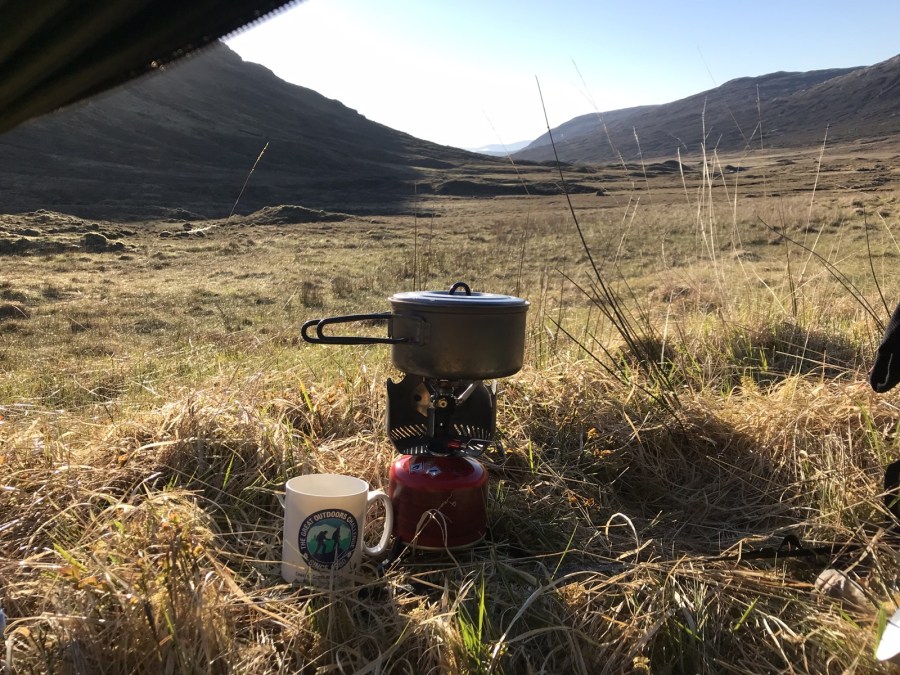
Fast boil times sound impressive. However running a stove at full power isn’t best for fuel efficiency. Turning the stove down a little and waiting a minute or two for your tea or coffee saves fuel. Other simple ways to reduce fuel use are to have a lid on the pot and to use a windscreen. Heat exchanger pots also make a big difference.
Whichever stove you choose it’s always best to practise with it at home rather than trying to work out how to light it on a windy hillside. Stoves are potentially dangerous so knowing how to operate one safely is essential.
What camping stove you choose depends on where you plan to go with it, in what conditions, and how you use your hot water. That and your budget – there’s a wide range of prices here too. Looking for advice for maintaining a stove? Our guide on how clean a camping stove will help you there.
Why you can trust The Great Outdoors
The Great Outdoors is here to help you make the most of your time outside. We have been helping people to explore from sea to summit, valley to mountain top for over 40 years. Our gear tests remain completely impartial. If you are wary of websites that only review brands that advertise with them, or sceptical of social media accounts always singing the praises of their latest freebie, you’ve come to the right place! Our reviews rank #1 for rigour, trustworthiness, and independence, and our gear testing team is the most experienced in Britain. With over 200 years’ experience between us, we are professional mountain leaders and instructors, wildlife photographers and rangers, outdoor authors, guidebook writers and trail addicts.
The best camping stoves we’ve tested
| Quick List |
|---|
| Gear of the Year Award Winner: Optimus Vega (available from Base Camp Food) |
| Best all-season efficiency: SOTO Fusion Trek (available from Ellis Brigham) |
| Lightest in test: Optimus Crux Lite (available from LD Mountain Centre) |
| Best for basecamp: Primus Tupike (available from alpinetrek.co.uk) |
| Best boil time: SOTO Windmaster Flex (available from LD Mountain Centre) |
| Best for windy conditions: MSR Windburner (available from Cotswold Outdoor and Cascade Designs) |
Gear of the Year Winner
Optimus Vega
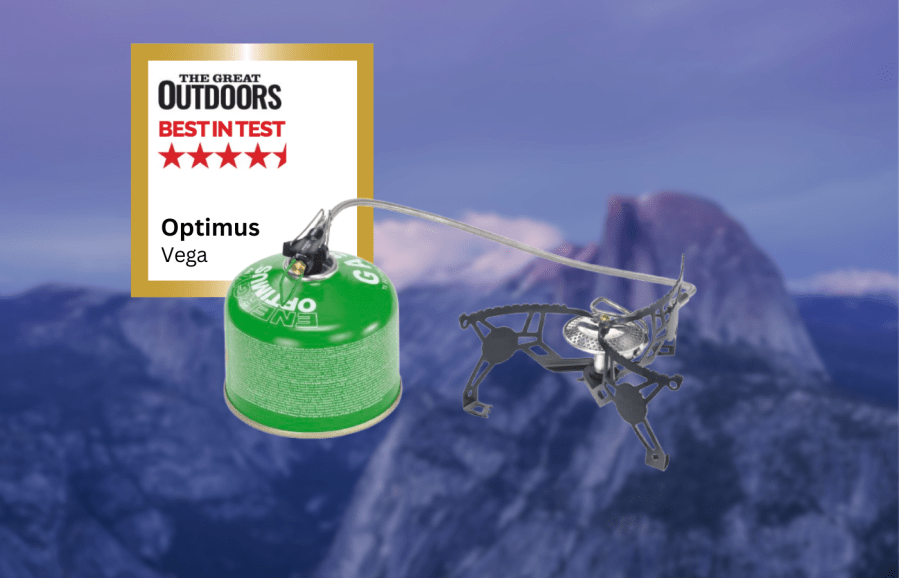
| Quick specs |
|---|
| Price: $119.95 / £139.99 (available from Base Camp Food) Weight: 178g katadyngroup.com |
The Optimus Vega is a remote canister stove suitable for year-round use. It has a preheat tube running over the burner that vaporises the gas, which means it can be used as a liquid fuel stove in subzero temperatures by inverting the canister. Unusually, it has flip-out wire legs to hold the inverted canister in place and enable the control lever to still be used. Optimus says that used like this it’ll work down to -20°C.
The Vega is compact when packed as the pot support/legs fold around the burner. At 178g it’s light for a remote canister stove. It has a low profile so stability is good and the pot supports are quite wide, making it fine for use with big pots. The burner is powerful and it boils water fast and works well for melting snow. Flame control is good for simmering. It’s fuel efficient too, though fuel usage increases when the canister is inverted so this should only be done when necessary. The Vega comes with a foil disc to place under it to prevent it scorching the ground, but not a windscreen, which is needed in strong winds. One is available separately, the Optimus Wind Foil, which weighs 36g and costs £7.70. The Vega itself costs £139.99. Tester Peter Macfarlane says “the Vega is excellent – a reliable go-to and brilliant in the tent porch.”
Read more: Peter’s full Optimus Vega review
Best all-season efficiency
SOTO Fusion Trek

David Lintern’s Best in Test
It’s super-stable and all-season-capable, and is built to last. It can simmer, not just nuke, water; it can cook for one or for five; and it’s economical to run.- all-season remote canister design
- fuel efficiency
- price
- slightly bulkier than other options
- pan and windshield not included
| Quick specs | |
|---|---|
| Price: $84.95 / £65 Weight: 186g Type: Pressure-regulated remote-canister stove Fuel: Gas Dimensions: 11x6x10cm Burner diameter: 6cm Power: 3260W / 11000BTU Boil Time Average: 4min on test Burn Time Approx: 90min from a 230g canister (quoted) sotooutdoors.com |
In brief and for those who don’t know the brand, The SOTO Fusion Trek camping stove is a remote-canister version of the well regarded Windmaster stove. There’s a fairly wide burner, with around 300 burn holes sitting in a concave circular ‘tray’ and surrounded by a lip of metal. The three legs extend very securely, and the pot supports are integral to the legs, making for a very stable base. The hose to the canister is very flexible, which may sound trivial, but if you’ve ever wrestled a stiff fuel hose and a windshield together in the cold, you’ll realise how useful this is. Even the canister attachment is well-designed and has a wired hoop control for fine flame control at the canister end.
The Fusion Trek gets my Best Buy because of its versatility. It’s super-stable and all-season-capable, and is built to last. It can simmer, not just nuke, water; it can cook for one or for five; and it’s economical to run.
Read more: David’s full SOTO Fusion review
Best boil time
SOTO Windmaster 4Flex

Chris’ Best in Test
The Windmaster is a close to perfect backpacking stove (I would like to see permanently attached pot supports) suitable for year-round use.- Fast boil time
- Good flame control
- Stable with big pots
- Lighweight
- Cost
- Detachable pot supports
- Not full windproof
| Quick specs | |
|---|---|
| Price: $69.95 / £65 Weight: 88g Accessories: piezo igniter Fuel: butane/propane canister Packed Dimensions: 9.2 x 8.5 cm (with supports folded in place) Burner Diameter: 4cm Burner weight: 61g without supports Power: 3260w/11000 BTU Boil time: std pot 2 min 48 sec. HX pot 1min 25sec. Fuel used: std pot 10g. HX pot 6g. sotooutdoors.com |
The Soto Windmaster 4Flex camping stove is lightweight, fast-boiling, and well-suited for year-round use. It features four pot supports for stability and is wide enough to support large pots. The stove’s wind resistance is achieved through a raised rim around the burner and the closeness of the pot to the flame. However, a windscreen is recommended in strong winds.
In tests, the Soto Windmaster 4Flex had the fastest boil times and excellent flame control. Fuel efficiency is comparable to the heavier Primus PrimeTech stove. The stove has a regulated burner, ensuring minimal performance drop even on frosty mornings. It is suitable for winter use, especially with an HX pot.
The stove also has a built-in piezo igniter, which is better protected than other stoves and has not failed. The Windmaster is a close-to-perfect backpacking stove, but it would benefit from permanently attached pot supports for year-round use.
Read more: Chris’ full Soto Windmaster 4Flex review – and see why it won in the TGO Gear of the Year Awards 2024.
Jetboil Stash

David Lintern recommends
There’s a lot to like here. It’s a simple, very light design that packs small and will allow basic cooking.- Weight
- Compact size
- Reasonable Simmer control
- No wind resistance without a windshield (not inlcluded)
- No pressure regulator
| Quick specs | |
|---|---|
| Price: $127.95 | £155 (available now from alpinetrek.co.uk) Weight: 232g including burner, pot and canister stand (24g) Type: Unregulated pressure canister-top stove system with integrated pan and heat exchanger Fuel: Gas Dimensions: Pot 0.8 Litres, 10x12cm Burner diameter: 4cm Power: 1318W/ 4500BTU Boil time: Average 5min on test Burn time: Approx 80min from a 230g canister (quoted) |
The Jetboil Stash camping stove was big news when unveiled a year or two ago as the lightest in the range. It achieved the 200g-ish all-in weight by dumping some of the features found on larger and heavier models. The Stash too is a ‘stove system’, but it’s really packable. The 0.8 litre pot is wide rather than tall, making it less prone to burning food and easier to stir the contents. It’s more than big enough for most solo meals (and will hold a 100g canister if you wish). There’s a very solid integrated handle that folds over the plastic lid, which has a built-in drainer.
There’s a lot to like here. It’s a simple, very light design that packs small and will allow basic cooking. For longer, warmer-weather trips nothing else is needed.
Read more: David Lintern’s full review of the Jetboil Stash
Primus PrimeTech Stove Set 1.3L

Chris recommends
The PrimeTech Camping Stove Set is an excellent choice for group cooking. It’s designed for 1-3 people but is rather big and heavy for solo use.- Windscreen
- Heat exchanger pot
- Stable
- Fast boil
- Good flame control
- Quiet burner
- Ceramic pot easily scratched
- Quite heavy
| Quick specs | |
|---|---|
| Price: £165 Weight: 875g Accessories: windscreen, 1.3 litre pot with heat exchanger, 1.3 litre pot, pot gripper, piezo Igniter, insulated storage bag Fuel: butane/propane canister Packed Dimensions: 19 x 13.5cm Burner Diameter: 4cm Burner weight: 336g Power: 2000w, 7000 BTU Boil time: std pot 3min 5sec. HX pot 2min 10sec Fuel used: std pot 10g. HX pot 6g. https://primusequipment.co.uk |
The PrimeTech Camping Stove Set is a versatile and efficient cooking tool designed for 1-3 people. It is large and heavy for solo use but can also be used with larger pots. The burner is integrated into the windscreen and pot supports, providing stability and a low profile. Primus provides a foil heat reflector to prevent scorching the earth.
The stove also features a preheat tube for better performance in freezing conditions. The burner is quiet, unlike most canister stoves. The set includes two pots, a 65g detachable lockable pot grip, a separate 40g Piezo igniter, and a 60g insulated storage bag that doubles as a pot cosy. One pot has a heat exchanger and a non-stick ceramic coating, making it more fuel-efficient.
The ceramic coating prevents food sticking but is easily scratched. The stove is easy to assemble and use, but assembling the set can be challenging. The storage bag keeps everything in place, making it a convenient choice for group cooking.
Read more: Chris’ full Primus PrimeTech Stove Set 1.3L review – and see why it was highly commended in the TGO Gear of the Year Awards 2024.
Alpkit Koro

David Lintern recommends
I like the Alpkit Koro enough to own one; I bought and paid for the unit on test. It’s simple, light, packs down small and is inexpensive.- inverted canister all-season use
- suits variety of pots
- price
- marginally less efficient than other comparable stoves on test
- pan and windshield not included
| Quick specs | |
|---|---|
| Price: £41 Weight: 126g Type: Pressure-regulated remote-canister stove with preheat tube Fuel: Gas Dimensions: 8x8x9cm Burner diameter: 8cm Power: 2800W / 9553BTU Boil time Average: 5min on test Burn time Approx: 70min from a 230g canister (quoted) www.alpkit.com |
The Alpkit Koro has three legs and three pot supports. The Koro is pretty powerful, but there are faster units out there. The burner has no inherent wind resistance other than it being close to the ground, and so a half-height windshield is essential. Similarly, simmer control is OK, but not world-beating. The ability to invert the canister in colder temperatures or when near the end of the canister is really useful.
I like the Alpkit Koro enough to own one; I bought and paid for the unit on test, last year. It’s simple, light, packs down small and is inexpensive. There are other options here that will boil faster using less gas, and I’d prefer the pot supports to be a little more robust; but the Koro operates on a principle of good enough – and most of the time it’s just that.
Read more: David’s full Alpkit Koro review
MSR Switch Stove System

Chris’ verdict
Overall, the Switch is an efficient system with an interesting and unusual pot. It’s not the lightest option but the price is reasonable.- Regulated burner
- Fast boil time
- Pot design
- Tall & narrow pot
- Not that light
| Quick Specs | |
|---|---|
| Price: $139.95 / £135 (available from Cascade Designs) Weight: 389g complete, burner & pot w/out accessories 328g Fuel: isobutane/propane Dimensions: stove 9.4 x 8.4cms, pot 17.7 x 11cms Burner Diameter: 2.8cms Power: 7100 BTU, 2100W Boil time: 2 minutes 45 seconds Fuel Used: 10 grams www.msrgear.com |
The latest combined stove and pot system from MSR – the MSR Switch Stove System – has a unique design unlike anything I’ve seen before. It’s very different to MSR’s other stove systems, the well-established Reactor and Windburner, which have radiant burners and can only be used with compatible heat exchanger MSR pots. The lighter weight Switch has a standard burner and is more versatile as it can be used with any pots. The cost is also much lower.
Read more: Chris’ full MSR Switch Stove System review
Trangia 27-2 UL

Chris recommends
Trangias are long-lasting – mine is over 40 years old and still works fine. If weight isn’t a major factor it’s an excellent choice. I wouldn’t choose one for lightweight backpacking though.- Windproof
- Stable
- Durable
- Good pots
- Low cost
- Heavy
- Bulky
| Quick specs | |
|---|---|
| Price: £73.20 Weight: 825g Accessories: windscreen/pot support, 2 1 litre aluminium pans, 0.6 litre kettle, frypan/plate/lid, pot grab, simmer ring Fuel: methylated spirits/denatured alcohol/gel fuel Packed Dimensions: 19 x 10cm Burner Diameter: 5cm Burner weight: 70g Power: 1000w Boil time: std pot 8min 20sec. HX pot 7min 30sec. Fuel used: std pot 25ml. HX pot 20ml. https://trangia.se |
The Trangia is the original camping stove system, launched in the 1950s. It features a rigid two-part aluminum windshield that protects the brass burner in strong winds. The stove comes with a simmer ring, a metal circle that covers flame holes with a movable lid that can be adjusted to block part of the open well. This device works well but is crude.
The Trangia 27-1 is the smallest and lightest of the complete Trangia stove sets, suitable for 1-2 people. It comes with two 1 litre aluminium pots and a kettle. Heavier versions are available with non-stick and hard anodised aluminium pots. The Trangia 27-2 is suitable for 1-2 people but has slow boil times compared to canister stoves.
Trangias are long-lasting, with a 40-year-old model still functioning fine. They are an excellent choice for weight-conscious travelers, but not for lightweight backpacking. The Trangia is long-lasting and works well for 1-2 people, but not for lightweight backpacking.
Read more: Chris’ full Trangia 27-2 UL review
Best wind resistance
MSR Windburner
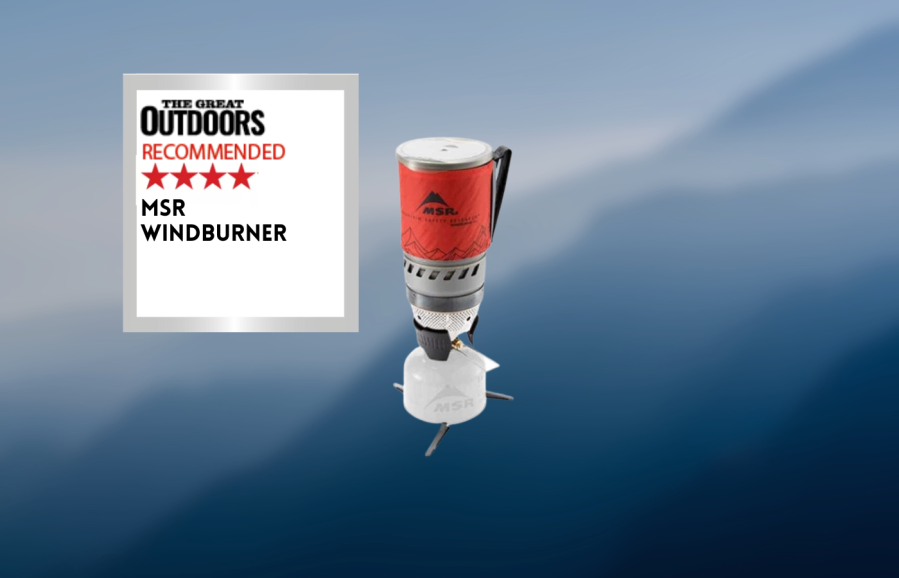
Chris recommends
The Windburner shines as a winter stove and in very windy conditions but is quite heavy for summer use.- Wind resistance
- Fast boil time
- Good fuel efficiency
- Simmers well
- Quite heavy
- Narrow pot
- Can’t use other pots
- Expensive
| Quick specs | |
|---|---|
| Price: $199.95 / £200 (available from Cotswold Outdoor and Cascade Designs) Weight: 425g Accessories: 1 litre pot with heat exchanger & insulated pot cozy, 0.5 litre bowl, canister support Fuel: butane/propane canister Packed Dimensions: 18 x 11.5 cm Burner Diameter: 7cm Burner weight: 198g Power: 2050ww/7000 BTU Boil time: 2min 36sec Fuel used: 8g https://www.msrgear.com |
The MSR Windburner is a heat exchanger camping stove with a regulated burner that is ideal for melting snow and freezing temperatures. It is designed for one person and can hold 1 liter of water, but it is best used with a smaller amount to avoid boiling over. The flame control is good for simmering food, but it is easy to turn off due to the lack of visibility.
The regulated burner glows red and is surrounded by a windshield, which locks the pot securely. The unit is tall and narrow, making it difficult to topple over. Boil time is fast and fuel efficiency is good. The stove has a cozy round pot and a semi-rigid fabric handle for a good grip.
The lid is transparent and has strainer and drinking holes, but it warps after use. The pot is tall and narrow, ideal for boiling water but not for cooking. Due to its proprietary fit, it can only be used with larger MSR pots. The MSR Windburner is suitable for winter and windy conditions but heavy for summer use.
Read more: Chris’ full MSR Windburner review
Jetboil Micromo

Chris recommends
For solo backpackers this is the best complete stove system I’ve tried though it is more expensive and heavier than putting together your own stove and HX pot combination- Regulated Burner
- HX pot
- Fast boil
- Good simmer control
- Not fully windproof
- Expensive
| Quick specs | |
|---|---|
| Price: £175 Weight: 349g Accessories: 0.8 litre pot with heat exchanger & insulated pot cozy, 0.3 litre bowl, pot support for other pots, piezo igniter, canister stand Fuel: butane/propane canister Packed Dimensions: 15.5 x 11.5cm Burner Diameter: 3.5cm Burner weight: 132g Power: 1750w/6000 BTU Boil time: std pot 4 min 10sec. HX pot 2min 14sec Fuel used: std pot 11g. HX pot 6g. https://www.jetboil.co.uk |
The Jetboil MicroMo camping stove is a lightweight and compact cooking system designed for solo use. It features a heat exchanger pot locked onto a regulated burner, resulting in a fast boil time with the supplied pot.
The stove’s hard anodized pot is tall and narrow, with a secure grip and a twist-lock mechanism. The stove can topple over unless on a level surface, and a 26g canister stand helps prevent it from falling off. A separate pot support is also provided, allowing for the use of other pots. A shallow plastic cover for the base adds 33g.
The Jetboil MicroMo is excellent for cooking, but it may not be fully windproof, so a foil windscreen is recommended. For solo backpackers, this is the best complete stove system, though it is more expensive and heavier than assembling your own stove and HX pot combination.
Read Chris’ full Jetboil MicroMo Review.
Lightest in test
Optimus Crux Lite

Chris recommends
Overall the Crux Lite is best kept for three season use for which it is excellent.- Powerful
- Lightweight
- Low cost
- Not wind resistant
- Not suitable for big pots
| Quick specs | |
|---|---|
| Price: £45 Weight: 75g Accessories: none Fuel: butane/propane canister Packed Dimensions: 7.1 x 5.6 Burner Diameter: 4.7cms Weight: 75g Power: 3000w/1200 BTU Boil time: std pot 3 min 15sec. HX pot 1min 50sec. Fuel used: std pot 10g. HX pot 8g. https://www.katadyngroup.com |
The Optimus Crux Lite is a compact, lightweight canister top camping stove that is easy to set up and light. It features three serrated pot support arms that fold over the burner, and a large wire flame control that folds inwards. The stove is best used with small pots for stability, as the pot supports are not very wide. Wider pot supports are recommended for better stability. The stove lacks wind resistance, so a windshield is needed. A foil one-round three-sided stove works well for ventilation and temperature control.
In above freezing temperatures, the Optimus Crux Lite performs well, boiling water quickly and simmering well, using less gas than heat exchanger stoves. However, its burner is not regulated, making performance less efficient in cold weather. Boiling 500ml of water at -2°C took eight and a half minutes, using 14 grams of fuel. Warming the cartridge and insulating it from the ground can help, but the Crux Lite is best kept for three-season use, where it is excellent.
Read Chris’s full Optimus Crux Lite review.
Best for basecamp
Primus Tupike

David recommends
The Tupike is a two burner camping stove desgined for basecamps and backpacking, it is large and heavy but beautifully finished and is a bit of a gas guzzler.- Genuine simmer-capable cooking stove
- Made to last
- Thirsty on fuel
| Quick specs | |
|---|---|
| Price: $260 | £240 (Buy now from alpinetrek.co.uk) Weight: 4.3kg Type: Pressure-regulated dual burner base camp stove Fuel: Gas Dimensions: 8x48x30cm Burner diameter: 4.6cm Power: 3000W / 1023BTU Boil time: average 5min on test Burn time: approx 47min from a 230g canister (quoted) |
The Tupike is a two-burner camping stove designed for basecamps and backpacking. It has two independent burners, two piezo igniters and two flame controls, and a griddle. It is large and heavy, but is also beautifully finished in brass, oak and brushed aluminium. It sits on two locking and folding legs and has adjustable windshields and a splashback. However, its fuel efficiency is a bit of a gas guzzler, so it should be used with larger canisters and boil/rest cycles to conserve fuel.
Read David’s full review on the Primus Tupike.
MSR Reactor 1L
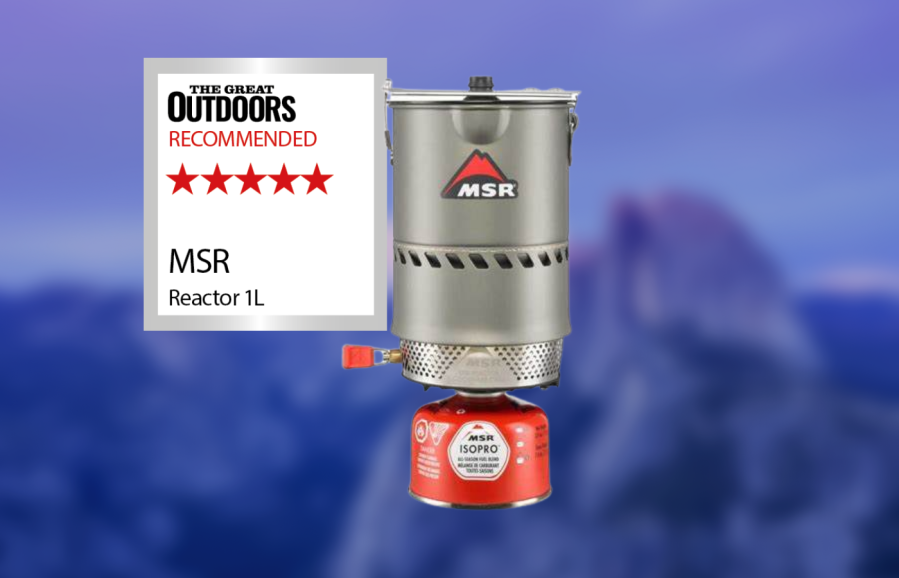
David recommends
It is a one-trick pony and expensive, but it is perfect for short, sharp missions to the mountains, especially in winter.- Rapid boil
- Excellent wind resistance
- Compact
- No simmer capability
| Quick specs | |
|---|---|
| Price: $270 | £295 (Buy now from alpinetrek.co.uk) Weight: 432g Type: pressure-regulated, radiant burner stove system with integrated pan and heat exchanger Fuel: gas Dimensions: 12×14.5cm Burner diameter: 10cm Power: 9000W / 3070BTU Burn time: approx 80min from a 230g canister (quoted) |
The Reactor is a high-performance camping stove designed to melt snow and boil water quickly. It is wind-resistant and uses both convective heat and radiant light energy. It has a solid, all-metal handle that stays cool to the touch and folds away securely over a pot lid with a strainer and steam release. The pressure regulator gives an even burn and it was the only stove on test to beat its quoted boil times. It is a one-trick pony and expensive, but it is perfect for short, sharp missions to the mountains, especially in winter.
Read David’s full review on the MSR Reactor 1L.
Alpkit Bruler

Chris’ verdict
Whilst boil times are much slower than a canister stove the advantages of the Bruler are that meths/ denatured alcohol is found in far more places than canisters and that it’s silent.- Durable
- Low cost
- Needs windshield
| Quick specs | |
|---|---|
| Price: £30 Weight: 165g Accessories: windscreen, flame regulator Fuel: methylated spirits/denatured alcohol/gel fuel Packed Dimensions: 8 x9 cm Burner Diameter: 5cm Burner weight: 70g Power: n/a Boil time: std pot 9min 23sec, HX pot 7min 50 sec Fuel used: std pot 25ml. HX pot 20ml. https://alpkit.com |
The Alpkit Bruler is a compact meths camping stove with a brass burner and an anodised aluminium windshield. It has fold-out legs and pot supports, and is stable with large pots, but small narrow ones may not balance well. The stove works well in breezes but requires a separate windshield for strong winds. The power output is almost identical to the Trangia, but a separate windshield is needed for strong winds.
The Bruler is suitable for solo use, as it weighs 429 grams with a foil windscreen and a 1 liter HX pot. Boil times are slower than canister stoves, but it is more accessible and silent. It allows for brewing up and listening to bird songs. While not ideal for quick brews, it is suitable for those not in a hurry. The Bruler is a good choice for those who don’t want the bulk and weight of the Trangia stove.
Read Chris’ full Alpkit Bruler review.
Robens Fire Beetle

Chris’ verdict
The Fire Beetle is made from stainless steel and should last well. That does make it quite heavy though. The cost is low and it is good value for money.- Stable
- Low profile
- Low cost
- No pre-heat tube
- Needs windscreen
- Not that light
| Quick specs | |
|---|---|
| Price: £41 Weight: 205g Accessories: none Fuel: Butane/propane canister Packed Dimensions: 12.8 x 7cm Burner Diameter: 4.5cm Burner weight: 205g Power: 3000w Boil time: 2min 58sec std pot, 1min 50sec HX pot Fuel used: 10g std pot, 8g HX pot https://www.robens.de |
Remote canister camping stoves are ideal for big pots due to their stability and wide legs. The Robens Fire Beetle is a popular choice for those who are nervous about the burner and pot sitting on top of the canister. It features three fold-out legs and a flame control lever on the canister. However, it lacks a foil windscreen and a preheat tube, making it a three-season stove.
The burner is not regulated, making it less effective in cold or empty canisters. A windshield is essential for better performance. The Fire Beetle is made from stainless steel and should last well, but it is quite heavy.
Despite its weight, the Robens Fire Beetle is a good value for money, with a low cost and good value for money. The stove works well with both standard and HX pots, boiling water quickly and simmering well.
Read Chris’ full Robens Fire Beetle review.
MSR Pocket Rocket Deluxe
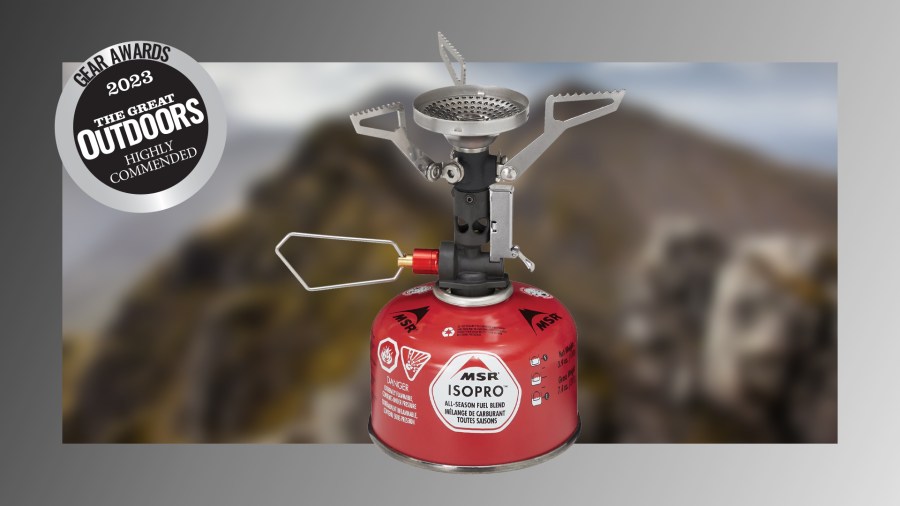
The TGO verdict
MSR have a reputation for making camping stoves with versatility and performance, and this is no exception.- Pressure regulator
- Efficiency
- Boil time
- Simmer control
- Build Quality
- Nothing
| Quick specs | |
|---|---|
| Price: $85 | £70 Weight: 82g + 17g case Dimensions: 180mm/ 65mm Burner Diameter: 47mm Power: 10,400/ 3200 W Boil time: 1min 35 secs Gas used: 9g |
MSR have a reputation for making camping stoves with versatility and performance, and this is no exception. The Pocket Rocket Deluxe is lightweight and compact, has a very fast boil time yet is efficient and easy to control with a lower flame. The built-in Piezo is positive, firing with a single click, and close to the canister so distant from the flame. The pressure regulator works extremely well, even with low gas levels and in cold conditions and the combination of price, weight, performance and MSR attention to detail on every aspect of the design and function makes this a top choice.
Read Judy Armstrong’s full review on the MSR Pocket Rocket Deluxe – and learn why it was highly commended in the TGO Gear Awards 2023.
How we test these camping stoves
In this guide you will find reviews from Chris Townsend and David Lintern. Most were originally published in the August 2024 issue of The Great Outdoors but we have also updated this gear guide with the latest tests as new innovations come onto the market.
Chris’ testing notes
The stoves were used on year-round trips in the Scottish Highlands in different conditions, mostly in 2023 and 2024, though in one case going all the way back to 1978!
In controlled conditions in still air I boiled 500ml of water in each stove with a standard pot and a heat exchanger pot (except for the MSR Windburner as this can’t be used with a different pot). Boiling times indicate the power of the stove. In cold weather, especially when melting snow, this can be important. I also measured how much fuel was used, which I think is more significant than boiling time, especially on multi-day walks. The results show that HX pots are more fuel efficient and reduce boil times with all stoves.
Go System 2250 canisters were used with the gas stoves, Bartoline methylated spirits with the Trangia and Alpkit Bruler stoves. For stoves that don’t come with pots I used 1 litre hard anodised aluminium pots – the GSI Pinnacle Soloist and Fire Maple FMC-XK6 HX.
In field use several variables – air temperature, water temperature, wind speed and more – will produce different results so these figures are comparative only.
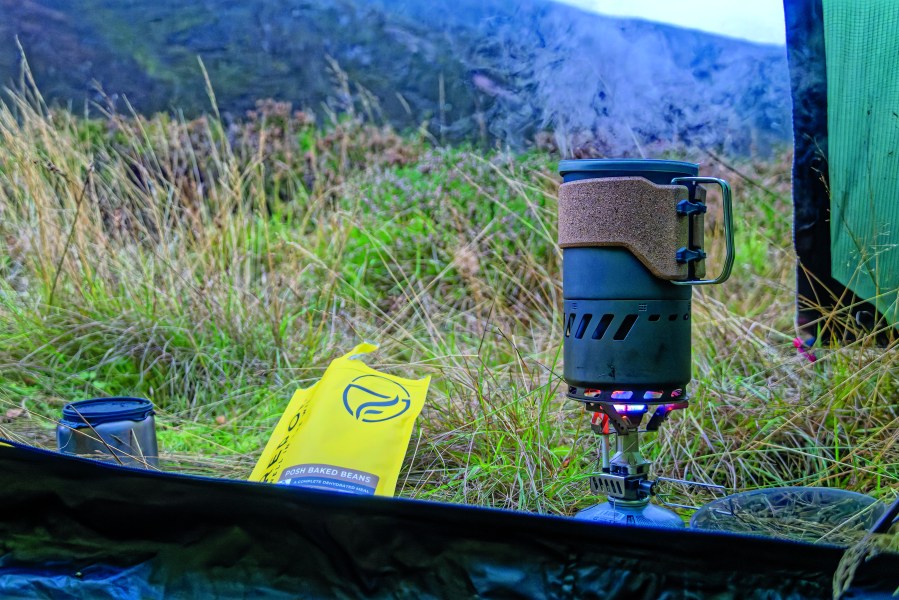
David’s testing notes
David tested his stoves on walks and backpacks from glen level to Munro summits across the eastern and western Highlands in 2024. It was winter on the tops and spring in the glens. He tends to boil water for dehydrated meals, but his budget is supermarket rather than branded outdoor sachets. As such, his food needs longer to hydrate and he does a little more in-pot preparation, rather than just pour-and-wait. This makes a difference to what he looks for in a stove.
Measuring stove performance is as hard as or harder than evaluating sleeping bags as there are so many variables – “but at least I was able to drink lots of tea as I tested,” he said. When deciding on a purchase, it’s worth looking closely at the power output and burn times in conjunction with David’s boil times, which he averaged over multiple uses in different conditions. There is no industry standard, and quoted figures need to be read with care and balanced with the comments in review.

What to look for in camping stoves
Fuel
Butane/propane in canisters is hot, convenient, and clean. Stoves generally have good flame control. Methylated spirits/denatured alcohol/gel fuel doesn’t give out as much heat and flame control is poor. However only the amount needed needs to be carried and it isn’t a petroleum product. Meths stoves are silent too.
Burner Head
Small diameter burner heads are best used with narrow pots. Wider burner heads spread the flame more efficiently and work well with larger pans.
Stability
Stability can be an issue with canister stoves. The simplest – a gas head that screws onto a canister – need a very stable base to counteract the effect of perching a loaded pan on top of a stove, on top of a canister. By contrast, a remote canister stove sits on the ground with its own legs and is attached to the canister by a flexible fuel hose. It has the additional advantage of allowing the canister to be inverted in cold weather or when nearly empty.

Burner diameter
Gas stoves with small-diameter burner heads can create intense burn zones, or hot spots, on cooking pans. Others are wide but work less well with taller, thinner pots. Some stoves come as complete ‘systems’, with exchangers built into the accompanying pan to distribute heat more evenly. Pan materials also matter: thin titanium is prone to hot spots; stainless steel is better; a thick aluminium pan is best at dispersing heat.
Efficiency
Fuel efficiency is a trade-off between weight, speed, size, design and the conditions of use. It’s impacted by ambient temperature, altitude and wind, and is difficult to measure accurately. A heat exchanger pot or a pressure regulator can improve fuel efficiencies. In Britain the most common type of gas canister cartridge is screw-on, and most contain a mix of butane, isobutane and propane. Isobutane has better vapour pressure and offers superior performance, especially in low temperatures. Butane is the cheapest but poorest-performing fuel in the mix.
Gas
Brands will specify their stoves should only be used with their own brand gas canisters. In reality they will work with any canister with a compatible connection (in Britain, the most common type is the screw-on). Virtually all compact cartridges contain a mix of butane, isobutane and propane. Isobutane is far superior in terms of vapour pressure, and high vapour pressure translates to better performance, especially in low temperatures. Isobutane is more expensive to source than butane, so you’ll usually find it in higher-quality canisters. Normal butane is the cheapest and poorest-performing fuel in the mix. Burning efficiency is also reduced by cold temperatures, high altitude and wind.
Windshield
A windshield is needed with every stove in any wind stronger than a light breeze. Some stoves come with windshields as part of the design. Fully encircling foil windshields can be used with remote canister stoves. Canister top stoves shouldn’t be fully surrounded by a windshield as the cartridge needs to be kept cool.
Pans
Camping stoves with small diameter burner heads can create intense burn zones, or hot spots, on cooking pans. Titanium pans have thin bases so are prone to this, stainless steel is better, a thick aluminium pan is best at dispersing heat.
Controls
Stoves may have compact gas control dials, or wire hoops that fold out, which can provide finer control of the flame and reduce the risk of burning fingers or sleeves. Onboard piezo igniters are a nice convenience, but it’s worth carrying a fire steel and/or a lighter in case of failure. Multifuel stoves come with a pump system to fit pressurised fuel bottles.
Many people talk about the ‘Big Three’ when it comes to hiking and camping: that’s your backpack, your backpacking tent and your sleeping bag. For backpacking, we think it’s better to think about a ‘Big Four’ with that extra digit accounting for your cooking system.
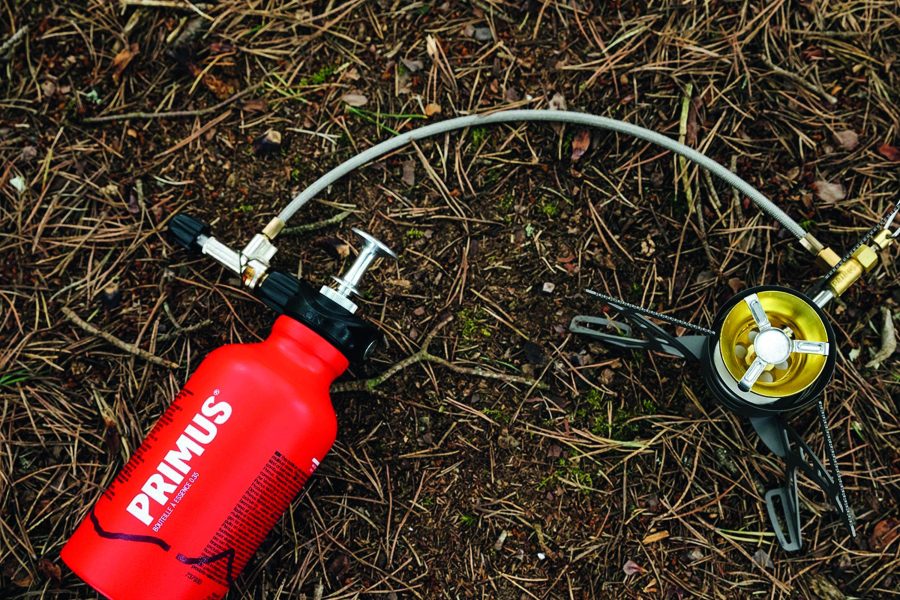
Heat Exchanger
Sets of radiator-like fins attached to the base of a pot are designed to reduce heat loss and increase fuel efficiency and boil times. These are provided with some stoves as part of a component system. Heat exchanger (HX) pots can be bought separately.
Regulated and non-regulated canister stoves
Canisters lose pressure as the gas is released. This happens more rapidly in cold weather. Below zero power output can double the time it takes water to boil. If the canister is less than half full water may not boil at all. Keeping the canister warm helps – in your sleeping bag overnight, putting your hands round it for example. A better solution is a stove with a regulated burner that controls the pressure for a more consistent performance. Regulated burners perform better with an almost empty canister though there’s still some drop off in power.
Pre-heat Tubes
A pre-heat tube is a loop of the fuel line that runs over the burner so it is heated by the flame. They are found on some remote cartridge stoves. A preheat tube means the cartridge can be inverted in cold weather to turn it into a liquid feed stove – the liquid turns to gas when heated in the pre-heat tube. Such stoves are excellent in sub-zero temperatures.
Pot Supports
The width and strength of the pot supports determines how heavy a pot they can safely support.
Piezo Ignition
Many stoves have Piezo ignition. This is fine – when it works. Such ignition can easily be damaged so carrying a back-up is a good idea.






